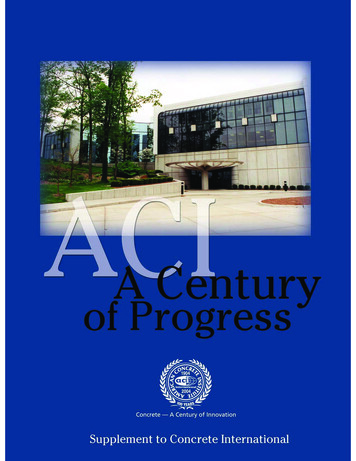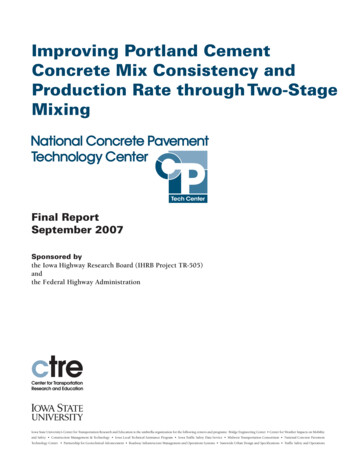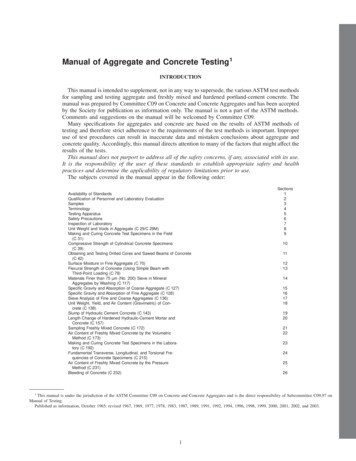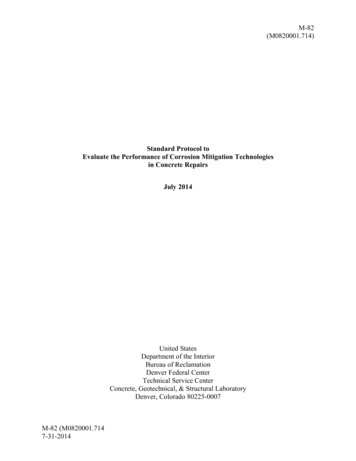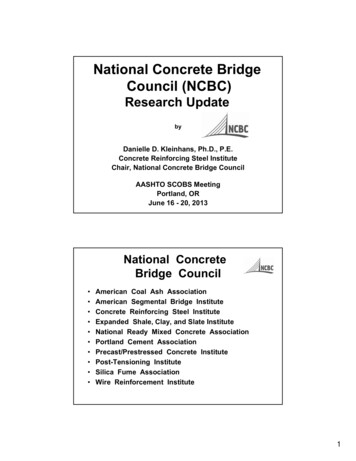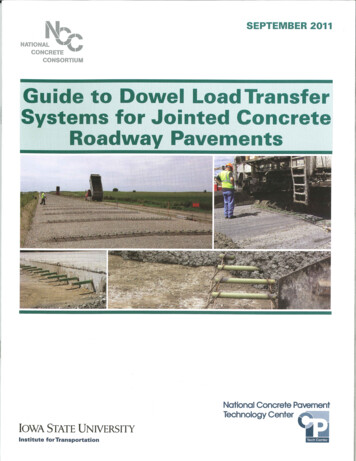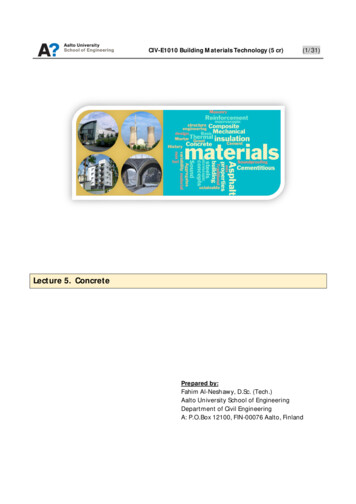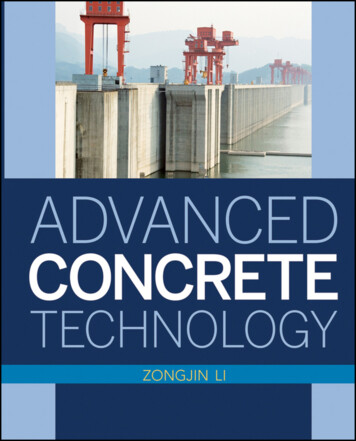
Transcription
Advanced ConcreteTechnology
Advanced ConcreteTechnologyZongjin LiJOHN WILEY & SONS, INC.
This book is printed on acid-free paper.Copyright 2011 by John Wiley & Sons, Inc. All rights reservedPublished by John Wiley & Sons, Inc., Hoboken, New JerseyPublished simultaneously in CanadaNo part of this publication may be reproduced, stored in a retrieval system, or transmitted in any form or by any means,electronic, mechanical, photocopying, recording, scanning, or otherwise, except as permitted under Section 107 or 108of the 1976 United States Copyright Act, without either the prior written permission of the Publisher, or authorizationthrough payment of the appropriate per-copy fee to the Copyright Clearance Center, 222 Rosewood Drive, Danvers, MA01923, (978) 750-8400, fax (978) 646-8600, or on the web at www.copyright.com. Requests to the Publisher forpermission should be addressed to the Permissions Department, John Wiley & Sons, Inc., 111 River Street, Hoboken,NJ 07030, (201) 748-6011, fax (201) 748-6008, or online at www.wiley.com/go/permissions.Limit of Liability/Disclaimer of Warranty: While the publisher and the author have used their best efforts in preparingthis book, they make no representations or warranties with respect to the accuracy or completeness of the contents ofthis book and specifically disclaim any implied warranties of merchantability or fitness for a particular purpose. Nowarranty may be created or extended by sales representatives or written sales materials. The advice and strategiescontained herein may not be suitable for your situation. You should consult with a professional where appropriate.Neither the publisher nor the author shall be liable for any loss of profit or any other commercial damages, includingbut not limited to special, incidental, consequential, or other damages.For general information about our other products and services, please contact our Customer Care Department within theUnited States at (800) 762-2974, outside the United States at (317) 572-3993 or fax (317) 572-4002.Wiley also publishes its books in a variety of electronic formats. Some content that appears in print may not beavailable in electronic books. For more information about Wiley products, visit our web site at www.wiley.com.Library of Congress Cataloging-in-Publication Data:Li, Zongjin, Dr.Advanced concrete technology / Zongjin Li.p. cm.Includes index.ISBN 978-0-470-43743-8 (cloth); ISBN 978-0-470-90239-4 (ebk); ISBN 978-0-470-90241-7 (ebk);ISBN 978-0-470-90243-1 (ebk); ISBN 978-0-470-95006-7 (ebk); ISBN 978-0-470-95166-8 (ebk);ISBN 978-0-470-95188-0 (ebk)1. Concrete. I. Title.TP877.L485 2011620.1 36—dc222010031083Printed in the United States of America10 9 8 7 6 5 4 3 2 1
To students, teachers, researchers, and engineers in the field of concrete, who are the driving forcesfor the development of the science and technology of concrete, including the personnel workingon the China 973 project, Basic Study on Environmentally Friendly Contemporary Concrete(2009CB623200).
CONTENTSPrefacexi11Introduction to Concrete1.1Concrete Definition and Historical Development1.2Concrete as a Structural Material 71.3Characteristics of Concrete 101.4Types of Concrete 141.5Factors Influencing Concrete Properties 161.6Approaches to Study Concrete 19Discussion Topics 21References 222Materials for Making Concrete2.1Aggregates 232.2Cementitious Binders2.3Admixtures 682.4Water 85Discussion Topics 88Problems 89References 9032331Fresh Concrete3.13.23.33.43.53.63.7194Workability of Fresh Concrete 94Mix Design 107Procedures for Concrete Mix Design 116Manufacture of Concrete 122Delivery of Concrete 123Concrete Placing 125Early-Age Properties of Concrete 135vii
ContentsviiiDiscussion TopicsProblems 137References 1384137Structure of Concrete1404.1Introduction 1404.2Structural Levels 1414.3Structure of Concrete in Nanometer Scale: C–S–H Structure4.4Transition Zone in Concrete 1524.5Microstructural Engineering 156Discussion Topics 162References 1635Hardened Concrete5.1Strengths of Hardened Concrete 1645.2Stress–Strain Relationship and Constitutive Equations5.3Dimensional Stability—Shrinkage and Creep 1975.4Durability 216Discussion Topics 246Problems 246References 2486Advanced Cementitious Composites1451641892516.1Fiber-Reinforced Cementitious Composites 2516.2High-Strength Cementitious Composites 2706.3Polymers in Concrete 2816.4Shrinkage-Compensating Concrete 2926.5Self-Compacting Concrete 2966.6Engineered Cementitious Composite 3106.7Tube-Reinforced Concrete 3126.8High-Volume Fly Ash Concrete 3166.9Structural Lightweight Concrete 3176.10Heavyweight Concrete 317Discussion Topics 317Problems 319References 3207Concrete Fracture on 326Linear Elastic Fracture Mechanics 330The Crack Tip Plastic Zone 337Crack Tip Opening Displacement 340Fracture Process in Concrete 342Nonlinear Fracture Mechanics for Concrete 346Two-Parameter Fracture Model 348Size Effect Model 355The Fictitious Model by Hillerborg 364R-Curve Method for Quasi-Brittle Materials 369326
ContentsixDiscussion TopicsProblems 375References 3798374Nondestructive Testing in Concrete Engineering3818.1Introduction 3818.2Review of Wave Theory for a 1D Case 3948.3Reflected and Transmitted Waves 4038.4Attenuation and Scattering 4068.5Main Commonly Used NDT-CE Techniques 4078.6Noncontacting Resistivity Measurement Method 458Discussion Topics 468Problems 469References 4729The Future and Development Trends of Concrete4769.19.29.3Sustainability of Concrete 476Deep Understanding of the Nature of Hydration 483Load-Carrying Capability–Durability Unified Service Life DesignTheory 4859.4High Toughness and Ductile Concrete 487References 489Index491
PREFACEConcrete is the most widely used material in the world. It plays an important role in infrastructureand private buildings construction. Understanding the basic behaviors of concrete is essential forcivil engineering students to become civil engineering professionals. There have been some verygood books regarding concrete, including Concrete by Mindess, Young, and Darwin, Concrete:Structure, Properties, and Materials by Mehta and Monteriro, and Concrete Technology byNeville and Brook. The motivation to write this book is to introduce new methodologies, newdevelopments, and new innovations in concrete technology. The unique features of this bookinclude the introduction of end use guided research strategy for concrete, unification of materialsand structures studies, and an emphasize on fundamental exploration of concrete structures,state of art of concrete development, and innovations. This book provides more comprehensiveknowledge on concrete technology, including the systematic introduction of concrete fracturemechanics and nondestructive evaluation for concrete engineering.The book is divided into nine chapters. Chapter 1 gives a brief introduction of concrete,including its historic development and advantages. Chapter 2 provides the knowledge of rawmaterials used for making concrete, covering aggregates, binders, admixtures, and water. Chapter3 discusses the properties of fresh concrete, including workability and the corresponding measurement methods. Chapter 4 focuses on the structure of concrete at different scales, especiallythe calcium silicate hydrate at nanometer scale. Chapter 5 covers the properties of hardenedconcrete, including strength, durability, stress–strain relation, and dimension stability. Chapter 6provides updated knowledge on various cement-based composites, including self-consolidationconcrete, ultra-high-strength concrete, and extruded and engineered cementitious composites.Chapter 7 focuses the fracture behavior of concrete and provides the basic knowledge of fracture mechanics of concrete. Chapter 8 covers the essential knowledge of nondestructive testingof concrete engineering, including wave propagation theory in 1-D case, detecting principles ofdifferent NDT methodologies and techniques of different NDT methods. In Chapter 9, the issuesregarding the future and development trend of concrete have been discussed.Although the book is designed and written primarily to meet the teaching needs for undergraduate students at senior level and graduate students at entry level, it can serve as a referenceor a guide for professional engineers in their practice.xi
xiiPrefaceIn the process of writing this book, the authors received enthusiastic help and invaluableassistance from many people, which is deeply appreciated. The authors would like to expresshis special thanks to Dr. Garrison C. K. Chau, Dr. Biwan Xu, and Dr. Jianzhong Shen for theirhelp in editing the book draft. Mr. Mike Pomfret is acknowledged for his professional pageproofreading. The photos provided by Profs. Wei Sun, Tongbo Sui, Linhai Han, and Zhen He;Drs. Xiaojian Gao, Herbert Zheng, and Jinyang Jiang; Mr. Peter Allen; and the companies ofOve Arup and Gammon are greatly appreciated.The support from China Basic Research Grant, Basic Research on Environmentally FriendlyContemporary Concrete (2009CB623200) is greatly acknowledged.Finally, I would like to thank for my wife, Xiuming Cui, my daughters Yexin Li and AileenLi for their love, understanding, and support.
Advanced ConcreteTechnology
CHAPTER1INTRODUCTION TO CONCRETE1.1CONCRETE DEFINITION AND HISTORICAL DEVELOPMENTConcrete is a manmade building material that looks like stone. The word “concrete” is derivedfrom the Latin concretus, meaning “to grow together.” Concrete is a composite material composed of coarse granular material (the aggregate or filler) embedded in a hard matrix of material(the cement or binder) that fills the space among the aggregate particles and glues them together.Alternatively, we can say that concrete is a composite material that consists essentially of a binding medium in which are embedded particles or fragments of aggregates. The simplest definitionof concrete can be written asconcrete filler binder(1-1)Depending on what kind of binder is used, concrete can be named in different ways. Forinstance, if a concrete in made with nonhydraulic cement, it is called nonhydraulic cementconcrete; if a concrete made of hydraulic cement, it is called hydraulic cement concrete; if aconcrete is made of asphalt, it is called asphalt concrete; if a concrete is made of polymer, itis called polymer concrete. Both nonhydraulic and hydraulic cement need water to mix in andreact. They differ here in the ability to gain strength in water. Nonhydraulic cement cannot gainstrength in water, while hydraulic cement does.Nonhydraulic cement concretes are the oldest used in human history. As early as around6500 bc, nonhydraulic cement concretes were used by the Syrians and spread through Egypt, theMiddle East, Crete, Cyprus, and ancient Greece. However, it was the Romans who refined themixture’s use. The nonhydraulic cements used at that time were gypsum and lime. The Romansused a primal mix for their concrete. It consisted of small pieces of gravel and coarse sand mixedwith hot lime and water, and sometimes even animal blood. The Romans were known to havemade wide usage of concrete for building roads. It is interesting to learn that they built some 5300miles of roads using concrete. Concrete is a very strong building material. Historical evidencealso points out that the Romans used pozzalana, animal fat, milk, and blood as admixtures forbuilding concrete. To trim down shrinkage, they were known to have used horsehair. Historicalevidence shows that the Assyrians and Babylonians used clay as the bonding material. Lime wasobtained by calcining limestone with a reaction of1000 CCaCO3 CaO CO2(1-2)When CaO is mixed with water, it can react with water to formambient temperatureCaO H2 O Ca (OH)2(1-3)1
Chapter 1 Introduction to Concrete2and is then further reacted with CO2 to form limestone again:ambient temperatureCa (OH)2 CO2 H2 O CaCO3 2H2 O(1-4)The Egyptians used gypsum mortar in construction, and the gypsum was obtained by calciningimpure gypsum with a reaction of107 130 C2CaSO4 · H2 O 2CaSO4 · 12 H2 O 3H2 O(1-5)When mixed with water, half-water gypsum could turn into two-water gypsum and gain strength:ambient temperature2CaSO4 · 12 H2 O 3H2 O 2CaSO4 · 2H2 O(1-6)The Egyptians used gypsum instead of lime because it could be calcined at much lowertemperatures. As early as about 3000 bc, the Egyptians used gypsum mortar in the constructionof the Pyramid of Cheops. However, this pyramid was looted long before archeologists knewabout the building materials used. Figure 1-1 shows a pyramid in Gaza. The Chinese also usedlime mortar to build the Great Wall in the Qin dynasty (220 bc) (see Figure 1-2).A hydraulic lime was developed by the Greeks and Romans using limestone containingargillaceous (clayey) impurities. The Greeks even used volcanic ash from the island of Santorin,while the Romans utilized volcanic ash from the Bay of Naples to mix with lime to producehydraulic lime. It was found that mortar made of such hydraulic lime could resist water. Thus,hydraulic lime mortars were used extensively for hydraulic structures from second half of thefirst century bc to the second century ad However, the quality of cementing materials declinedthroughout the Middle Ages. The art of burning lime was almost lost and siliceous impuritieswere not added. High-quality mortars disappeared for a long period. In 1756, John SmeatonFigure 1-1 Pyramid built with gypsum mortar in Gaza, Egypt
1.1 Concrete Definition and Historical Development3Figure 1-2 The Great Wall, built in the Qin dynastywas commissioned to rebuild the Eddystone Light house off the coast of Cornwall, England.Realizing the function of siliceous impurities in resisting water, Smeaton conducted extensiveexperiments with different limes and pozzolans, and found that limestone with a high proportionof clayey materials produced the best hydraulic lime for mortar to be used in water. Eventually,Smeaton used a mortar prepared from a hydraulic lime mixed with pozzolan imported from Italy.He made concrete by mixing coarse aggregate (pebbles) and powdered brick and mixed it withcement, very close to the proportions of modern concrete. The rebuilt Eddystone Lighthouselasted for 126 years until it was replaced with a modern structure.After Smeaton’s work, development of hydraulic cement proceeded quickly James Parkerof England filed a patent in 1796 for a natural hydraulic cement made by calcining nodules ofimpure limestone containing clay. Vicat of France produced artificial hydraulic lime by calciningsynthetic mixtures of limestone and clay. Portland cement was invented by Joseph Aspdinof England. The name Portland was coined by Aspdin because the color of the cement afterhydration was similar to that of limestone quarried in Portland, a town in southern England.Portland cement was prepared by calcining finely ground limestone, mixing it with finely dividedclay, and calcining the mixture again in a kiln until the CO2 was driven off. This mixture wasthen finely ground and used as cement. However, the temperature claimed in Aspdin’s inventionwas not high enough to produce true Portland cement. It was Isaac Johnson who first burned theraw materials to the clinkering temperature in 1845 to produce modern Portland cement. Afterthat, the application of Portland cement spread quickly throughout Europe and North America.The main application of Portland cement is to make concrete. It was in Germany that the firstsystematic testing of concrete took place in 1836. The test measured the tensile and compressivestrength of concrete. Aggregates are another main ingredient of concrete, and which include sand,crushed stone, clay, gravel, slag, and shale. Plain concrete made of Portland cement and aggregateis usually called the first generation of concrete. The second generation of concrete refers tosteel bar-reinforced concrete. François Coignet was a pioneer in the development of reinforcedconcrete. (Day and McNeil, 1996). Coignet started experimenting with iron-reinforced concretein 1852 and was the first builder ever to use this technique as a building material (Encyclopaedia
Chapter 1 Introduction to Concrete4Britannica, 1991). He decided, as a publicity stunt and to promote his cement business, to build ahouse made of béton armé, a type of reinforced concrete. In 1853, he built the first iron-reinforcedconcrete structure anywhere; a four-story house at 72 Rue Charles Michels (Sutherland et al.,2001). This location was near his family cement plant in St. Denis, a commune in the northernsuburbs of Paris. The house was designed by local architect Theodore Lachez (Collins, 2004).Coignet had an exhibit at the 1855 Paris Exposition to show his technique of reinforcedconcrete. At the exhibit, he forecast that the technique would replace stone as a means ofconstruction. In 1856 he patented a technique of reinforced concrete using iron tirants. In 1861he put out a publication on his techniques.Reinforced concrete was further developed by Hennebique at the end of the 19th century,and it was realized that performance could be improved if the bars could be placed in tension,thus keeping the concrete in compression. Early attempts worked, with the beams showing areduced tendency to crack in tension, but after a few months the cracks reopened. A gooddescription of this early work is given in Leonhardt (1964). The first reinforced concrete bridgewas built in 1889 in the Golden Gate Park in San Francisco, California.To overcome the cracking problem in reinforced concrete, prestressed concrete was developed and was first patented by a San Francisco engineer as early as 1886. Prestressed meansthat the stress is generated in a structural member before it carries the service load. Prestressedconcrete was referred to as the third generation of concrete. Prestressing is usually generatedby the stretched reinforcing steel in a structural member. According to the sequence of concretecasting, prestressing can be classified as pretensioning or post-tensioning. Pretensioning pullsthe reinforcing steel before casting the concrete and prestress is added through the bond builtup between the stretched reinforcing steel and the hardened concrete. In the post-tensioningtechnique, the reinforcing steel or tendon is stretched after concrete casting and the gainingof sufficient strength. In post-tensioning, steel tendons are positioned in the concrete specimenthrough prereserved holes. The prestress is added to the member through the end anchorage.Figure 1-3 shows the sequence of the pretensioning technique for prestressed concrete.Prestressed concrete became an accepted building material in Europe after World War II,partly due to the shortage of steel. North America’s first prestressed concrete structure, the WalnutRebarJack(1) Pre-stress rebarConcreteAnchor(2) Cast concrete(3) Release rebarFigure 1-3 Pretensioning sequence for prestressing concrete
1.1 Concrete Definition and Historical Development5Lane Memorial Bridge in Philadelphia, Pennsylvania, was completed in 1951. Nowadays, withthe development of prestressed concrete, long-span bridges, tall buildings, and ocean structureshave been constructed. The Barrios de Lura Bridge in Spain is currently the longest-span prestressed concrete, cable-stayed bridge in the world, with a main span of 440 m. In Canada, theprestressed Toronto CN tower reaches a height of 553 m.As a structural material, the compressive strength at an age of 28 days is the main designindex for concrete. There are several reasons for choosing compressive strength as the representative index. First, concrete is used in a structure mainly to resist the compression force. Second,the measurement of compressive strength is relatively easier. Finally, it is thought that other properties of concrete can be related to its compressive strength through the microstructure. Pursuinghigh compressive strength has been an important direction of concrete development. As early as1918, Duff Adams found that the compressive strength of a concrete was inversely proportionalto the water-to-cement ratio. Hence, a high compressive strength could be achieved by reducingthe w /c ratio. However, to keep a concrete workable, there is a minimum requirement on theamount of water; hence, the w /c ratio reduction is limited, unless other measures are provided toimprove concrete’s workability. For this reason, progress in achieving high compressive strengthwas very slow before the 1960s. At that time, concrete with a compressive strength of 30 MPawas regarded as high-strength concrete. Since the 1960s, the development of high-strength concrete has made significant progress due to two main factors: the invention of water-reducingadmixtures and the incorporation of mineral admixtures, such as silica fume, fly ash, and slag.Water-reducing admixture is a chemical admixture that can help concrete keep good workabilityunder a very low w /c ratio; the latter are finer mineral particles that can react with a hydrationproduct in concrete, calcium hydroxide, to make concrete microstructure denser. Silica fume alsohas a packing effect to further improve the matrix density. In 1972, the first 52-MPa concretewas produced in Chicago for the 52-story Mid-Continental Plaza. In 1972, a 62-MPa concretewas produced, also in Chicago, for Water Tower Place, a 74-story concrete building, the tallest inthe world at that time (see Figure 1-4). In the 1980s, the industry was able to produce a 95-MPaconcrete to supply to the 225 West Whacker Drive building project in Chicago, as shown inFigure 1-5. The highest compressive strength of 130 MPa was realized in a 220-m-high, 58-storybuilding, the Union Plaza constructed in Seattle, Washington (Caldarone, 2009).Concrete produced after the 1980s usually contains a sufficient amount of fly ash, slag,or silica fume as well as many different chemical admixtures, so its hydration mechanism,hydration products, and other microstructure characteristics are very different from the concreteproduced without these admixtures. Moreover, the mechanical properties are also different fromthe conventional concrete; hence, such concretes are referred to as contemporary concretes.There have been two innovative developments in contemporary concrete: self-compactingconcrete (SCC) and ultra-high-performance concrete (UHPC). SCC is a type of high-performanceconcrete. High-performance concrete is a concept developed in the 1980s. It is defined as aconcrete that can meet special performance and uniformity requirements, which cannot alwaysbe achieved routinely by using only conventional materials and normal mixing, placing, andcuring practices. The requirements may involve enhancement of the characteristics of concrete,such as placement and compaction without segregation, long-term mechanical properties, higherearly-age strength, better toughness, higher volume stability, or longer service life in severeenvironments.Self-compacting concrete is a typical example of high-performance concrete that can fillin formwork in a compacted manner without the need of mechanical vibration. SCC was initially developed by Professor Okamura and his students in Japan in the late 1980s (Ozama et al.,1989). At that time, concrete construction was blooming everywhere in Japan. Since Japan is in an
Chapter 1 Introduction to Concrete6Figure 1-4Gao)Water Tower Place in Chicago, Illinois, USA (Photo provided by Xiaojianearthquake zone, concrete structures are usually heavily reinforced, especially at beam–columnjoints. Hence, due to low flowability, conventional concrete could hardly flow past the heavyreinforced rebars, leaving poor-quality cast concrete and leading to poor durability. Sometimes,the reinforcing steel was exposed to air immediately after demolding. To solve the problem, Professor Okamura and his students conducted research to develop a concrete with high flowability.With the help of the invention of the high-range water reducer or plasticizer, such a concretewas finally developed. They were so excited that they called this concrete “high-performanceconcrete” at the beginning. It was corrected later on to SCC, as HPC covers broader meanings.Durability is a main requirement of HPC. It has been found that many concrete structures couldnot fulfill the service requirement, due not to lack of strength, but to lack of durability. For thisreason, concrete with high performance to meet the requirement of prolonging concrete servicelife was greatly needed.In the 1990s, a new “concrete” with a compressive concrete strength higher than 200 MPawas developed in France. Due to the large amount of silica fume incorporated in such a material, it was initially called reactive powder concrete and later on changed to ultra-high-strength(performance) concrete (UHSC), due to its extremely high compressive strength (Richard andCheyrezy, 1995). The ultra-high-strength concrete has reached a compressive strength of 800 MPa
1.2 Concrete as a Structural Material7Figure 1-5 The 225 West Whacker Drive building in Chicago, Illinois, USA (Photoprovided by Xiaojian Gao)with heating treatment. However, it is very brittle, hence, incorporating fibers into UHSC is necessary. After incorporating fine steel fibers, flexural strength of 50 MPa can be reached. The firsttrial application of UHSC was a footbridge built in Sherbrooke, Canada (Aitcin et al., 1998).1.2CONCRETE AS A STRUCTURAL MATERIALIn this book, the term concrete usually refers to Portland cement concrete, if not otherwisespecified. For this kind of concrete, the compositions can be listed as follows:Portland cement water (& admixtures) cement paste fine aggregate mortar coarse aggregate concreteHere we should indicate that admixtures are almost always used in modern practice andthus have become an essential component of contemporary concrete. Admixtures are defined as
8Chapter 1 Introduction to Concretematerials other than aggregate (fine and coarse), water, and cement that are added into a concretebatch immediately before or during mixing. The use of admixtures is widespread mainly becausemany benefits can be achieved by their application. For instance, chemical admixtures can modifythe setting and hardening characteristics of cement paste by influencing the rate of cementhydration. Water-reducing admixtures can plasticize fresh concrete mixtures by reducing surfacetension of the water. Air-entraining admixtures can improve the durability of concrete, andmineral admixtures such as pozzolans (materials containing reactive silica) can reduce thermalcracking. A detailed description of admixtures is given in Chapter 2.Concrete is the most widely used construction material in the world, and its popularity canbe attributed to two aspects. First, concrete is used for many different structures, such as dams,pavements, building frames, or bridges, much more than any other construction material. Second,the amount of concrete used is much more than any other material. Its worldwide productionexceeds that of steel by a factor of 10 in tonnage and by more than a factor of 30 in volume.In a concrete structure, there are two commonly used structural materials: concrete andsteel. A structural material is a material that carries not only its self-weight, but also the loadpassing from other members.Steel is manufactured under carefully controlled conditions, always in a highly sophisticatedplant; the properties of every type of steel are determined in a laboratory and described in amanufacturer’s certificate. Thus, the designer of a steel structure need only specify the steelcomplying with a relevant standard, and the constructor needs only to ensure that the correctsteel is used and that connections between the individual steel members are properly executed(Neville and Brooks, 1993).On the other hand, concrete is produced in a cruder way and its quality varies considerably.Even the quality of cement, the binder of concrete, is guaranteed by the manufacturer in a mannersimilar to that of steel; however, the quality of concrete is hardly guaranteed because of manyother factors, such as aggregates, mixing procedures, and skills of the operators of concreteproduction, placement, and consolidation.It is possible to obtain concrete of specified quality from a ready-mix supplier, but, even inthis case, it is only the raw materials that are bought for a construction job. Transporting, placing,and, above all, compacting greatly influence the quality of cast concrete structure. Moreover,unlike the case of steel, the choice of concrete mixes is virtually infinite and therefore theselection has to be made with a sound knowledge of the properties and behavior of concrete.It is thus the competence of the designer and specifier that determines the potential qualities ofconcrete, and the competence of the supplier and the contractor that controls the actual qualityof concrete in the finished structure. It follows that they must be thoroughly conversant with theproperties of concrete and with concrete making and placing.In a concrete structure, concretes mainly carry the compressive force and shear force, whilethe steel carries the tension force. Moreover, concrete usually provides stiffness for structures tokeep them stable.Concretes have been widely used to build various structures. High-strength concrete hasbeen used in many tall building constructions. In Hong Kong, grade 80 concrete (80 MPa) wasutilized in the columns of the tallest building in the region. As shown in Figure 1-6, the 88-storyInternational Finance Centre was built in 2003 and stands 415 m (1362 ft) tall.Concrete has also been used in bridge construction. Figure 1-7 shows the recently builtSutong Bridge that spans the Yangtze River in China between Nantong and Changshu, a satellitecity of Suzhou, in Jiangsu province. It is a cable-stay
civil engineering students to become civil engineering professionals. There have been some very good books regarding concrete, including Concrete by Mindess, Young, and Darwin, Concrete: Structure, Properties, and Materials by Mehta and



